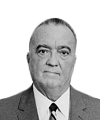Hoover Biography
|
| updated |
Copy Link Code
|
 Any accurate John Edgar Hoover biography must start with information about how it all began: his birth. As the first director of the Federal Bureau of Investigation (FBI), and one of the most controversial figures in U.S. history, it seems hard to believe he came from such a typical background.
Any accurate John Edgar Hoover biography must start with information about how it all began: his birth. As the first director of the Federal Bureau of Investigation (FBI), and one of the most controversial figures in U.S. history, it seems hard to believe he came from such a typical background.
Born in Washington, D.C. on New Year's Day in 1895, the Hoover biography is filled with a wide variety of foreign-born ancestry. His mother – Anna Marie Scheitlin Hoover – hailed from German Swiss ancestors, while his father – Dickerson Naylor Hoover – had both English and German ancestors. His maternal uncle was also an honorary Swiss consul general to the U.S.
Although he was born in Washington's Capital Hill neighborhood, just down the street from the heart of the nation's government, he did not have a birth certificate. Despite two siblings having the required official document, he didn't file one until he was 43 years old (in 1938). As a child, he suffered from severe stuttering; to overcome it, he taught himself to speak very quickly, carrying the habit into adulthood, making it extremely difficult for many stenographers to keep up. Growing up, he sang in the school choir at Central High, competed on the debate team with a cool demeanor and indisputable logic (to argue for women's right to vote and against abolishing the death penalty). He also participated in a school Reserve Officers' Training Corps, giving him a sample of military service experience.
Every bio of J. Edgar Hoover must mention his time at the Justice Department. Following his graduation from George Washington University, he was admitted to the bar in 1917. Immediately thereafter, he went to work at the Justice Department, in the War Emergency Division. Then, in August 1919, he became the head of the new General Intelligence Division (also called the Radical Division). During this time, he and his assistant – George Ruch – monitored and tracked numerous 'radicals' in the U.S., including Marcus Garvey. In 1924, he was appointed as sixth director of the Bureau of Investigation by Calvin Coolidge.
There are numerous J. Edgar Hoover biographies heralding his success as a gang-buster in the 1930s, when he went after reportedly dangerous criminal gang leaders such as John Dillinger, who was finally ambushed and killed in July 1934. However, Hoover continually denied the existence of the Mafia, while simultaneously winning unearned praise for capturing or shooting numerous outlaws and bank robbers. In 1935 the bureau was renamed (to the FBI) and in 1939 it established itself as a leader in domestic intelligence, with Hoover's insistence on expansion of fingerprinting files, investigation techniques, and agent training.
In nearly every J. Edgar Hoover biography, there is mention of his unauthorized, covert, and illegal investigation and surveillance of suspected 'radicals' or 'subversives'. Years later, when his true tactics and motivations were uncovered, many recognized he was clearly prejudiced by personal agendas, and an insatiable need to prove his necessity to the public. Many of those who were targeted for this unwarranted surveillance and spying had done nothing wrong, including civil rights leader Martin Luther King, Jr.
At his death, on May 2, 1972, J. Edgar Hoover was still the FBI's top leader. Having spent most of his life serving the bureau, it is no wonder that its main building in Washington, D.C. still carries his name to this day.
